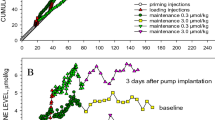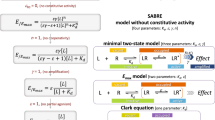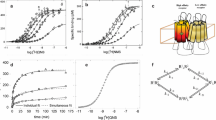Abstract
IF drugs b and c are competitive antagonists of drug a, then it would seem self evident that the addition of c to a system in which b was already present would increase the degree of block. But where the receptors are exposed to the agonist for only a short time there is another possibility. If the first antagonist dissociates from the receptors slowly, and the second rapidly, the additional presence of the second antagonist may increase the number of receptors effectively available to the agonist. If, for simplicity, it is supposed that equilibrium between receptors and both the agonist and the “fast” antagonist is instantaneous and that the dissociation rate of the “slow” antagonist is so small that no dissociation occurs during the period of exposure to the agonist, then it is easily shown that the action of the fast antagonist can be described by the relation  where ybc is the fraction of receptors occupied by the agonist in the presence of both slow (b) and fast (c) antagonists, yb the fraction occupied by the agonist in the presence of only b, X is the fraction of receptors which would have been occupied by c, Y by the agonist and Z by b at equilibrium if each of the substances had been present alone. Evidently, if ybc/yb is greater than 1, the addition of the fast antagonist will be expected to increase the response to a standard dose of agonist. Fig. 1 shows how ybc/yb varies with X and Z for two different values of Y. For the larger value of Y the paradoxical effect is observed for a range of values of X and Z; for the smaller value of Y, only additional block is seen. In general, ybc/yb cannot be greater than 1 if Y+Z < 1.
where ybc is the fraction of receptors occupied by the agonist in the presence of both slow (b) and fast (c) antagonists, yb the fraction occupied by the agonist in the presence of only b, X is the fraction of receptors which would have been occupied by c, Y by the agonist and Z by b at equilibrium if each of the substances had been present alone. Evidently, if ybc/yb is greater than 1, the addition of the fast antagonist will be expected to increase the response to a standard dose of agonist. Fig. 1 shows how ybc/yb varies with X and Z for two different values of Y. For the larger value of Y the paradoxical effect is observed for a range of values of X and Z; for the smaller value of Y, only additional block is seen. In general, ybc/yb cannot be greater than 1 if Y+Z < 1.
This is a preview of subscription content, access via your institution
Access options
Subscribe to this journal
Receive 51 print issues and online access
$199.00 per year
only $3.90 per issue
Buy this article
- Purchase on Springer Link
- Instant access to full article PDF
Prices may be subject to local taxes which are calculated during checkout
Similar content being viewed by others
References
Stephenson, R. P., Brit. J. Pharmacol. Chemother., 11, 379 (1956).
Waud, D. R., Pharmacol. Rev., 20, 49 (1968).
Author information
Authors and Affiliations
Rights and permissions
About this article
Cite this article
STEPHENSON, R., GINSBORG, B. Potentiation by an Antagonist. Nature 222, 790–791 (1969). https://doi.org/10.1038/222790a0
Received:
Issue Date:
DOI: https://doi.org/10.1038/222790a0
Comments
By submitting a comment you agree to abide by our Terms and Community Guidelines. If you find something abusive or that does not comply with our terms or guidelines please flag it as inappropriate.



